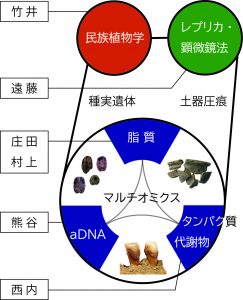B02:Archaeobotanical Research on Exchange and Transforms in Rice, Millet and Wheat Food Culture
What did the encounter of different food cultures based on different staple grains bring to the Chinese civilization? |
|
| Shinya SHODA (Nara National Research Institute for Cultural Properties) |
Recent investigations in the fields of archeology and archeological science have revealed that three food culture areas – the rice culture area (from the watershed of the Changjang River to South China), the millet culture area (from Northeast China to North China) and the wheat (and barley, dairy food) culture area (Central Asia) – interacted with each other in the eastern part of the Eurasian Continent from the Neolithic Age to the Bronze Age, and evolved through cultural exchange. We will clarify specific aspects of consumption and cooking by area and time, and conduct multifaceted analysis of plant remains, impressions on pottery and biomolecules preserved in pottery, dental calculus, and amorphous charred mateirals in addition to a conventional archeological review. We will also use our ethnobotanical knowledge and historical document to make our interpretation more practical.
We will research plant remains, impressions on the surface of pottery excavated from archaeological sites in China and Central Asia, indiscernible carbonized organic substances, biomolecular remains in pottery and dental calculus. We will also research how plant are being used in today’s farming and cooking practices.
The development of Chinese civilization has been intensively studied in Japan, Europe and the U.S., as well as in China, for a long time. Our study will newly include Central Asia and North Asia into the discussion areas and use the cutting-edge research methods of archeological biochemistry, including the research of biomolecules, which has developed rapidly in recent years. Thus, our attempt is a new challenge, unequaled anywhere in the world.
Members
| Principal investigator | Shinya SHODA | Nara National Research Institute for Cultural Properties |
|---|---|---|
| Co-investigator | Takumi NISHIUCHI | Kanazawa University |
| Masahiko KUMAGAI | National Agriculture and Food Research Organization Bioinformatics Team | |
| Eiko ENDO | Meiji University | |
| Emiko TAKEI | Osaka Gakuin University | |
| Natsuki MURAKAMI | Showa Women’s University | |
| Research collaborator | Motoki HARADA | Aichi Asahi Site Museum |
| Kazuyo NISHIHARA | Nara National Research Institute for Cultural Properties | |
| Yoko MURAKAMI | Disaster Management Library |


